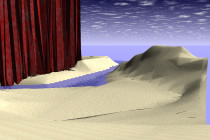| Cliff Stairs | Tasks |

|
|
|
The task is to design a staircase connection between two different precedent backpacking shelters on the site of the backpackers game. One shelter is to be located at one of five different chosen sites, the other at a different one of the chosen sites. The connection must bridge the gap between each design and provide a series of experiences that architecturally connect the space between your backpacking shelter and another precedent shelter (designed by someone else in the class from the backpackers game). The staircase must be composed of the following items. Firstly, a path (a line that traces the space that your eye would pass through if you were walking upon the staircase) and secondly a pair of platforms, designed in the style (flavour, language or grammar) of its closest backpacking shelter. On Designing The PathAlthough stairs are very structural objects, in this assignment you should focus on the shape of the line that a pedestrian’s eye would trace (while walking the stair), rather than on the structural integrity of the staircase. When you start designing the ‘path’ you should think about the types of experiences that you would like a person to have when they ascend or descend the stair. One good design strategy is that of serial revelation. In it, the path should gradually reveal the structures at either end, providing hints as to what is to come and only revealing a full view of the destination at a place late in the path. The path should be abstract and not a detailed design for a stair—this will save considerable time in its design and modelling. It must capture the general slope of each flight of stairs and the flatness of each landing. It need not capture more detail. If you find yourself designing stair treads, stop and think of better ways to spend your time. You should also not worry too much about how the stair is fastened to the cliff wall. But we do want it to weave through space, capturing in its design interesting, even dramatic, spatial experiences and views that a person would have when either ascending or descending the stair. The ten experiential images you produce must illustrate a linear and sequential process for either ascending or descending the staircase, not both. On Designing The Landing Because long staircases always have landings (platforms), your path will need to incorporate several resting points that conform to the technical requirements listed below. You should select two of the landings, and elaborate them with each taking the style (flavour, language or grammar) of its closest shelter. Here are some potential ways of thinking about the landings. They can provide resting points, viewing platforms that frame or mask your view, meeting points, landmarks, surveying points that inform you of the next part of your journey, information ioints, or connectors that connect multiple paths together. |